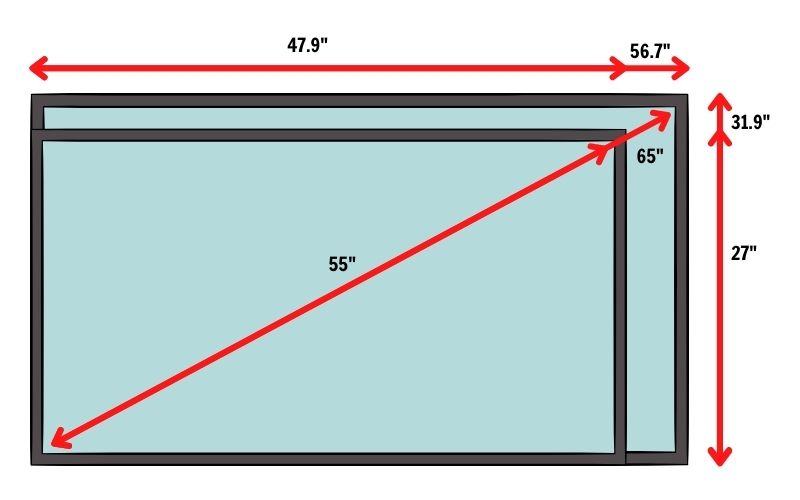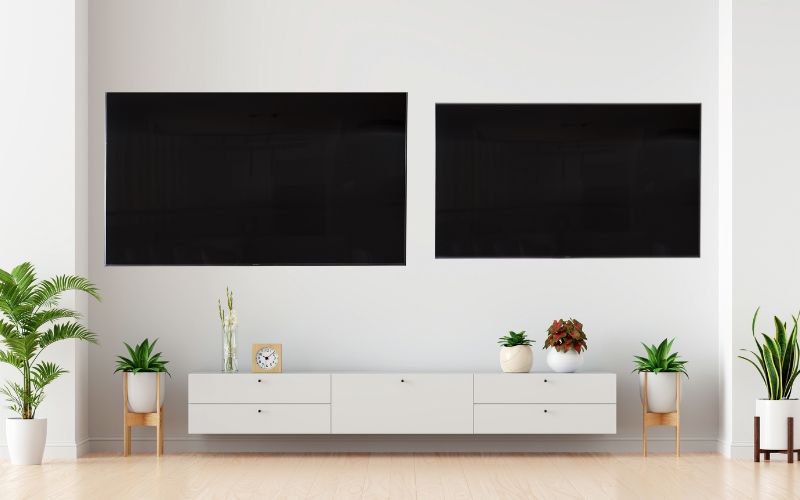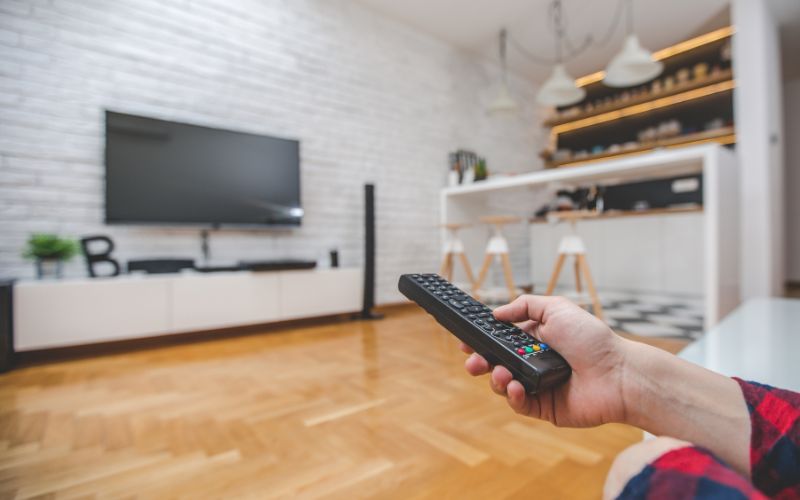When you’re looking for a new TV for your living room, it can be tough to judge what size you should be buying. You know you want a big screen – that’s easy. But how big is big enough? And what might be too big?

55-inch and 65-inch screens are the two most popular TV sizes you can buy right now, but is it simply a shoot-out between the dimensions of the TV, or are there other factors at play? Let me take you through it, so that you can have an easier, informed choice to make.
What is the difference between a 55-inch and 65-inch TV?
The main difference between a 55-inch and a 65-inch TV is the size. A 65-inch TV is much bigger, and may not be a suitable size for some smaller living rooms, especially if your couch is a little closer to where the TV will live.
It’s important to give a little bit of context to screen sizes. There are a wide range of TV sizes available now, usually starting at 32 inches and working right their way up to 85 inches, although some specialist models may be larger.
Broadly, these sizes are pretty standard. You can get 32-inch, 40-inch, 43-inch, 48-inch, and then from 50-inch upwards it tends to increase by 5” intervals, until you get to 75” and then 85” – there aren’t any 80” screens.
But of those, some are becoming less popular than others, in particular those screen sizes ending in a zero. When a top TV manufacturer releases a new TV now, their big screen options will be 55-inch, 65-inch, 75-inch and maybe 85-inch.
What that means is that you can usually get a 55-inch TV and 65-inch TV from the same range, so the features and tech are all identical – it’s just the screen size that’s different.
That’s not the case if you were to compare a 55-inch to a 50-inch TV, which are almost always a different range of TV, and so the differences are a lot wider.
55-inch And 65-inch TV Dimensions
Here’s how the two screens compare when it comes to dimensions:
| TV size | Corner to corner | Height | Width | Area |
|---|---|---|---|---|
| 55-inch | 55 inches | 27 inches | 47.9 inches | 1,293.3 square inches |
| 65-inch | 65 inches | 31.9 inches | 56.7 inches | 1,808.7 square inches |
That’s a pretty huge difference, made even clearer with this diagram. A 65-inch TV is almost 10 inches wider and is more than 4 inches taller, and that combined difference adds up to give you that screen that’s a full 10-inches bigger measured from one corner to another:

How much bigger is a 65-inch TV than a 55-inch?
A 65-inch TV is 8.8 inches wider and 4.9 inches taller than a 55-inch TV, meaning it is overall a much larger screen. In terms of area, the difference is 515.4 square inches, which is over 3.5 square feet of extra viewing space.
There really is a very noticeable difference between these two TVs, and a 65-inch will look much more impressive in your living room, provided you have the space for it.
A 55-inch TV is still a big screen, but it will fit in a room corner, or blend into a wall over time. A 65-inch TV will dominate a room for as long as you have it, which could be a good or bad thing depending on your preferences.
55 Vs 65 Inch TVs Side By Side
When you look at a 55-inch TV alongside a 65-inch TV, you’ll see just how much bigger the 65-inch model really is. Even though the height difference is only a few inches, you can see just how much more screen you get with a 65-inch model.

When comparing some TV models, you’ll notice that the TV itself can look a little bigger due to the bezel around the screen. All the measurements given above are for the actual screen only. But with 55-inch and 65-inch TVs falling into the same ranges, the bezel will look the same for comparable TVs, so the screen size alone will demonstrate the difference.
Should you buy a 55-inch or 65-inch TV?
The choice between a 55-inch and a 65-inch TV is straightforward since the features will be the same. How big a TV can you fit in your space, and what can you afford? If you have the money and the room, then a 65-inch will be much more impressive.
Let’s take a bit of a closer look at some of the factors that normally influence the decision on which TV to buy, so you can see how these two screen sizes compare.
Price
When you’re comparing the prices of a 55-inch and a 65-inch TV, you need to make sure you’re comparing two TVs from the same range, as that’s the only way to get a fair comparison.
After all, you could get a 65-inch TV with not many features for less than the better 55-inch TVs.
When you do compare like-for-like, it will depend on how good the TV is, but the best TVs will often have a price difference of around $500 – you’ll pay $1,100 for some of the best 55-inch TVs, and $1,600 or so for the equivalent 65-inch screen.
That’s a pretty huge difference and can certainly affect whether you want to buy the 65-inch model. With mid-range TVs, the price difference is usually more modest, around $200-300, so it depends on how good a TV you want.
SAMSUNG 55-Inch Class Crystal 4K Smart TV

- Witness millions of shades of color through powerful Dynamic Crystal technology
- See every detail with stunning clarity
- Alexa built-in
SAMSUNG 65-Inch Class Crystal 4K Smart TV

- Witness millions of shades of color through powerful Dynamic Crystal technology
- See every detail with stunning clarity
- Alexa built-in
Availability
Availability isn’t really a concern when you’re comparing 55-inch and 65-inch TVs. Because they are usually from within the same range, you’ll find the same manufacturers making both screen sizes. And as these are the two most popular screen sizes that customers currently buy, you aren’t going to struggle to find a model to choose from.
If anything, your problem with 55-inch and 65-inch TVs could be having too much choice. Deciding on the screen size might not be the issue, but narrowing down which model and manufacturer you buy could be confusing.
But there’s no difference between the two screen sizes when it comes to availability.
Size and viewing distance
As well as price, one of the biggest deciding factors in which TV to buy is going to be the size.
Both TVs are best suited to a living room and are usually too big for a bedroom. At most, you’ll want a 50-inch TV for a bedroom, but a 43-inch tends to be the best choice.

55-inch TVs will normally fit right into almost any living room, even if the space is a little more confined. They’re a big TV, but they’re not so huge that you have to plan to get them to fit in a corner, or see whether they’ll fit a space on the wall.
65-inch TVs are a lot bigger, so you absolutely have to do some measuring first to make sure the TV is going to fit in your space. You’ll also want to check the feet if you plan on having the TV on a stand. The feet on a 65-inch TV will be much further apart than on a 55-inch model, and if your stand isn’t wide enough then a 65-inch TV just won’t work.
Obviously, that’s not a concern if you’re wall mounting your TV, but you do need to bear in mind the wall mount you choose. Most wall mounts will easily hold a 55-inch TV, but you might need a specialist one for a bigger screen. Don’t skimp on a wall mount – you don’t want to invest in an epic 65-inch screen for it to come crashing down off the wall.
And check the viewing distances too. The optimum viewing distance for a 55-inch TV is around 7.5 feet, while it’s 9 feet for a 65-inch TV. If you’re sitting 7-8 feet from where your TV will be placed, you might have to move your neck to keep track of all the action happening across the screen.
But if you’re sat 9 feet away, a 55-inch TV might seem a tad small – you might not make out all of the finer details.
Features
In terms of features, 55-inch and 65-inch TVs are pretty much identical. You can get the same screen types, gaming features, sound tech and smart features from both screen sizes.
The only difference is in resolution. Most TVs in both sizes are 4K, but if you want an 8K screen they tend to start at 65-inches. You won’t find a 55-inch 8K screen.
While 8K content is exceptionally limited right now, if you want to future-proof your home and be ready for more 8K movies and shows in future, you’ll want to try to get a 65-inch TV, but beware as they are very expensive.
Is a 55-inch or 65-inch TV better for gaming?
Neither a 55-inch nor a 65-inch TV is suitable for gaming at a desk, they’re both way too big. For gaming in the living room, neither has the upper hand when it comes to gaming features – both will have the same HDMI 2.1 functionality and game modes within each TV range.

So again, it comes down simply to size and cost. If your living room is a suitable size for a 65-inch TV, then that will give you a more impressive and immersive gaming experience. Otherwise, a 55-inch TV is still going to look great.
For gaming at a desk, look for a TV no bigger than 43 inches.
The Best 55- To 65-Inch TV For The Money
As long as you have the space for it, there are few better TVs than this LG C1 OLED model. It’s an epic display with amazing color and contrast, and the latest tech that makes sure everything you watch looks incredible, even if it’s a film from decades ago. It’s packed with gaming features too, and some impressive sound tech – though you might still want to look at a soundbar to get the best overall experience.
LG OLED C1 Series 65” 4k Smart TV

- Over 8 million pixels
- Alexa Built-in
- A9 GEN 4 AI processor 4K
- Home cinema experience
The Bottom Line
Because most manufacturers release a 55-inch and a 65-inch version of the same TV, once you’ve decided which model you want it comes down to a simple case of size and price. How big a TV can you fit in your space, and how much do you want to spend?
Once you’ve worked that out, you’ll likely know which is the right one for you. But you might also want to think about energy consumption too, since a bigger TV will cost you more to run. Especially if you’re buying an OLED TV, like the one I’ve recommended above – those do like to use a lot of electricity.
Read more: How much electricity does a TV use?
